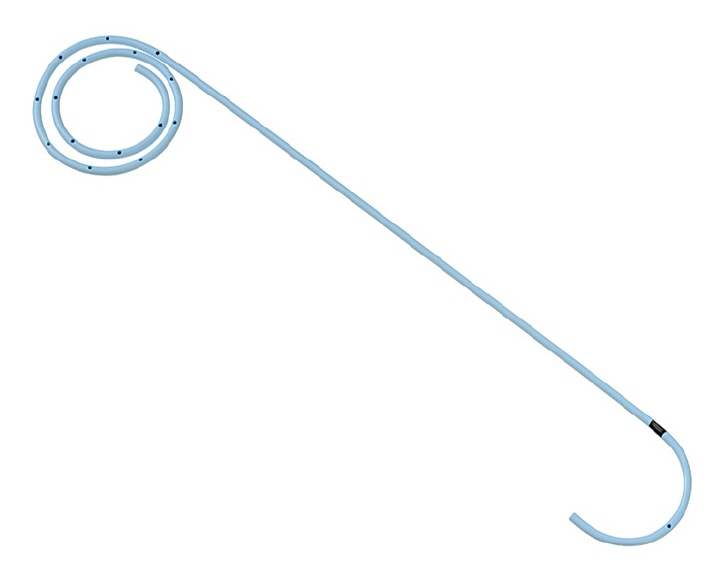Clin Endosc.
2024 Sep;57(5):647-655. 10.5946/ce.2023.284.
Prophylactic endoscopic transpapillary gallbladder stenting to prevent acute cholecystitis induced after metallic stent placement for malignant biliary strictures: a retrospective study in Japan
- Affiliations
-
- 1Department of Gastroenterology, Sendai City Medical Center, Sendai, Japan
- KMID: 2559216
- DOI: http://doi.org/10.5946/ce.2023.284
Abstract
- Background/Aims
Endoscopic biliary drainage using self-expandable metallic stents (SEMSs) for malignant biliary strictures occasionally induces acute cholecystitis (AC). This study evaluated the efficacy of prophylactic gallbladder stents (GBS) during SEMS placement.
Methods
Among 158 patients who underwent SEMS placement for malignant biliary strictures between January 2018 and March 2023, 30 patients who attempted to undergo prophylactic GBS placement before SEMS placement were included.
Results
Technical success was achieved in 21 cases (70.0%). The mean diameter of the cystic duct was more significant in the successful cases (6.5 mm vs. 3.7 mm, p<0.05). Adverse events occurred for 7 patients (23.3%: acute pancreatitis in 7; non-obstructive cholangitis in 1; perforation of the cystic duct in 1 with an overlap), all of which improved with conservative treatment. No patients developed AC when the GBS placement was successful, whereas 25 of the 128 patients (19.5%) without a prophylactic GBS developed AC during the median follow-up period of 357 days (p=0.043). In the multivariable analysis, GBS placement was a significant factor in preventing AC (hazard ratio, 0.61; 95% confidence interval, 0.37–0.99; p=0.045).
Conclusions
GBS may contribute to the prevention of AC after SEMS placement for malignant biliary strictures.
Keyword
Figure
Cited by 1 articles
-
Technical challenges and safety of prophylactic gallbladder stenting with metallic biliary stenting
Masood Muhammad Karim, Om Parkash
Clin Endosc. 2024;57(6):841-842. doi: 10.5946/ce.2024.193.
Reference
-
1. Isayama H, Yasuda I, Ryozawa S, et al. Results of a Japanese multicenter, randomized trial of endoscopic stenting for non-resectable pancreatic head cancer (JM-test): covered Wallstent versus double-layer stent. Dig Endosc. 2011; 23:310–315.2. Almadi MA, Barkun A, Martel M. Plastic vs. self-expandable metal stents for palliation in malignant biliary obstruction: a series of meta-analyses. Am J Gastroenterol. 2017; 112:260–273.3. Isayama H, Kawabe T, Nakai Y, et al. Cholecystitis after metallic stent placement in patients with malignant distal biliary obstruction. Clin Gastroenterol Hepatol. 2006; 4:1148–1153.4. Suk KT, Kim HS, Kim JW, et al. Risk factors for cholecystitis after metal stent placement in malignant biliary obstruction. Gastrointest Endosc. 2006; 64:522–529.5. Sogabe Y, Kodama Y, Honjo H, et al. Tumor invasion to the arteries feeding the gallbladder as a novel risk factor for cholecystitis after metallic stent placement in distal malignant biliary obstruction. Dig Endosc. 2018; 30:380–387.6. Gosain S, Bonatti H, Smith L, et al. Gallbladder stent placement for prevention of cholecystitis in patients receiving covered metal stent for malignant obstructive jaundice: a feasibility study. Dig Dis Sci. 2010; 55:2406–2411.7. Ishii T, Kin T, Yamazaki H, et al. Prophylactic endoscopic gallbladder stent placement for cholecystitis after covered metal stent placement for distal biliary obstruction (with video). Gastrointest Endosc. 2023; 98:36–42.8. Cotton PB, Lehman G, Vennes J, et al. Endoscopic sphincterotomy complications and their management: an attempt at consensus. Gastrointest Endosc. 1991; 37:383–393.9. Yokoe M, Hata J, Takada T, et al. Tokyo Guidelines 2018: diagnostic criteria and severity grading of acute cholecystitis (with videos). J Hepatobiliary Pancreat Sci. 2018; 25:41–54.10. Maruta A, Iwata K, Iwashita T, et al. Factors affecting technical success of endoscopic transpapillary gallbladder drainage for acute cholecystitis. J Hepatobiliary Pancreat Sci. 2020; 27:429–436.11. Khan MA, Atiq O, Kubiliun N, et al. Efficacy and safety of endoscopic gallbladder drainage in acute cholecystitis: is it better than percutaneous gallbladder drainage? Gastrointest Endosc. 2017; 85:76–87.12. Mohan BP, Khan SR, Trakroo S, et al. Endoscopic ultrasound-guided gallbladder drainage, transpapillary drainage, or percutaneous drainage in high risk acute cholecystitis patients: a systematic review and comparative meta-analysis. Endoscopy. 2020; 52:96–106.13. Nakahara K, Michikawa Y, Morita R, et al. Endoscopic transpapillary gallbladder stenting using a newly designed plastic stent for acute cholecystitis. Endosc Int Open. 2019; 7:E1105–E1114.14. Nakahara K, Sato J, Morita R, et al. Incidence and management of cystic duct perforation during endoscopic transpapillary gallbladder drainage for acute cholecystitis. Dig Endosc. 2022; 34:207–214.15. Wong M, Sánchez-Luna SA, Rustagi T. Endoscopic transpapillary gallbladder stenting to prevent acute cholecystitis in patients receiving FCEMS for benign biliary stricture. Endosc Int Open. 2021; 9:E1386–E1390.16. Kozakai F, Kanno Y, Ito K, et al. Endoscopic ultrasonography-guided gallbladder drainage as a treatment option for acute cholecystitis after metal stent placement in malignant biliary strictures. Clin Endosc. 2019; 52:262–268.17. Kanno Y, Kozakai F, Koshita S, et al. Technical issues stemming from endoscopic-ultrasound-guided gallbladder drainage: a single center experience. Turk J Gastroenterol. 2019; 30:1055–1061.18. Podboy A, Yuan J, Stave CD, et al. Comparison of EUS-guided endoscopic transpapillary and percutaneous gallbladder drainage for acute cholecystitis: a systematic review with network meta-analysis. Gastrointest Endosc. 2021; 93:797–804.19. McCarty TR, Hathorn KE, Bazarbashi AN, et al. Endoscopic gallbladder drainage for symptomatic gallbladder disease: a cumulative systematic review meta-analysis. Surg Endosc. 2021; 35:4964–4985.20. Nakahara K, Michikawa Y, Morita R, et al. Endoscopic transpapillary gallbladder stent placement in the presence of uncovered biliary metal stents using a through-the-mesh technique. VideoGIE. 2020; 5:296–299.21. Nakahara K, Morita R, Michikawa Y, et al. Endoscopic transpapillary gallbladder drainage for acute cholecystitis after biliary self-expandable metal stent placement. Surg Laparosc Endosc Percutan Tech. 2020; 30:416–423.
- Full Text Links
- Actions
-
Cited
- CITED
-
- Close
- Share
- Similar articles
-
- Current Status of Biliary Metal Stents
- The feasibility of percutaneous transhepatic gallbladder aspiration for acute cholecystitis after self-expandable metallic stent placement for malignant biliary obstruction: a 10-year retrospective analysis in a single center
- Endoscopic Transpapillary Gallbladder Stenting for Acute Cholecystitis in a Patient with Metastatic Pancreatic Cancer
- Endoscopic Ultrasonography-Guided Gallbladder Drainage as a Treatment Option for Acute Cholecystitis after Metal Stent Placement in Malignant Biliary Strictures
- Cholecystitis after Placement of Covered Self-Expandable Metallic Stents in Patients with Distal Malignant Biliary Obstructions






